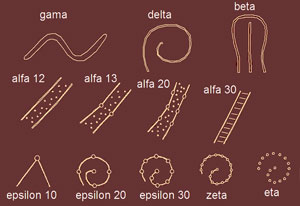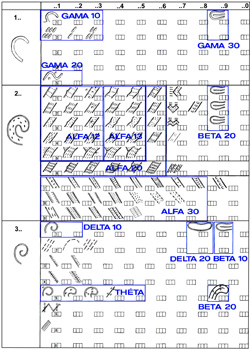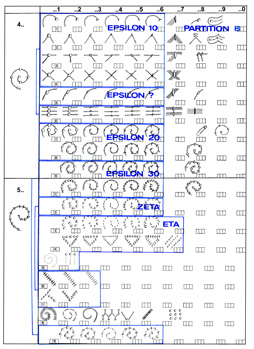Bylany.com >> Bylany >> LBK
Decoration codes
Already since the beginning of more systematic excavations (1956), evaluation of obtained evidence has been continuously proceeding. Preliminary simple quantitative analysis (Soudský 1960) was published for the first time at the end of 1950’s. There, basis of the Bylany settlement chronology was defined.
Due to immense quantity of obtained archaeological material it has proved to be necessary to process the material in completely new way using the so-called quantitative automated processing of artefacts.
There are two main approaches to processing of archaeological evidence:
1. The so-called verbal description of obtained objects. This approach was applied mainly in previous research but sometimes is still in use today. As an example, following description can be cited: Sherd from lower part of a thin-walled vessel decorated with narrow incised line with note symbols placed in folds or at the line-ends. Due to strong detrition of the surface, decoration is not well visible. The fragment is glued from two parts. Matrix is gray, floated with very fine tempering grits, with low temperature of firing. Although such verbal descriptions include wide quantity of data, their results can be, however, reversely abstracted with great difficulties. This type of description is aimed at archaeological finds as individual units, i.e. one particular axe, one pottery sherd, one fibula, etc.
2. Quantitative processing of archaeological evidence is based on an open code system applied on description of the most significant markers of artefacts (descriptors, characteristics, etc.). Such code system was created in Bylany already during the course of large-scale excavations, and was labelled as ‘-etic.’ Excavated features and artefacts are described by character numeric form. Primary codes themselves do not, however, represent the quantitative processing. If extremely extensive register of described markers (e.g. pottery attributes) is used, the scholar may envisage the same problem as in the case of verbal form of description: obtained and in that moment required data are lost in a pile of accumulated information. That is way secondary coding based on evaluated markers of original primary descriptive systems (coding) should follow. What aspect of artefact’s characteristics (properties) is chosen depends completely on researcher’s will. Secondary descriptive system (the so-called ‘-emic’) was created in Bylany by I. Pavlů on the basis of chronologically evaluated characteristics of the LnK pottery (Pavlů 1977).
Techniques of linear decoration:

a12 (alpha12)
represents classical filled band. Its individual variants do not have broader chronological significance. In general, however, this band is extremely important element for Bohemian LBK pottery.a13 (alpha13)
jis later version of a band filled with strokes. Notes on both border lines are characteristic for this decoration technique (after Pavlů – Rulf – Zápotocká 1986, 319-321).a20 (alpha20)
represents a later variant of filled band decoration that occurs, however, rarely on Bohemian LBK pottery. Thus, its chronological significance is very low.a30 (alpha30)
includes ladder-motives of all types. Significance of this decoration increases mainly in later development stage.b (beta)
consists of a group of triple-lined bands including classical A-shaped triple-line made of simple line, and two forms of a triple-line similar to the above-mentioned one that is, however, made by classical filled band technique (b20), and decorated with notes placed at the ends or in crossing points, rarely with notes sparsely distributed on the line (b30).g (gamma)
represents all forms of cannelure whether simple, cannelure with depressions or an A-shaped band made by cannelured line.d12(delta10,20)
is the most frequent type of linear decoration. Variants delta 10 and 20 include curvilinear as well as rectilinear decoration. Chronological significance of this type of decoration is, however, low.d30 (delta 30)
represents later form of a triple-line with distinct band contraction that does not create A-shaped decorations. Instead, spiral and zig-zag motives are rather common.e10 (epsilon10)
includes notes occurring only at the ends or in folds of the lines. Although this element is rather early, epsilon10 is mainly connected with rectilinear motives (after Pavlů – Rulf – Zápotocká 1986, 319-321).e20 (epsilon20)
is decoration consisting of a line with sparsely distributed notes.e? (epsilon?)
In this group are incorporated notes placed on lines that were discovered on small fragments. Thus, their precise location within the vessels’ decoration can not be stated (after Pavlů – Rulf – Zápotocká 1986, 319-321).e30 (epsilon30)
incorporates notes densely distributed on lines, and also (due to absence of any more detailed classification) combinations of various later forms of note techniques.zeta (zeta)
includes all later forms of notes distributed on pre-outlined lines and combination of dense short incisions placed on line (the so-called parrot-ladder motive). The zeta group is clear marker of terminal stage of note technique development since the note symbols began to prevail over the simple line technique.eta (eta)
This technique represents a row of strokes as a new advanced technique that abandons the present linear technique, and predates later development of proper stroked (stamped) decoration.theta
consists of incised decoration of lines with depressions (notes) set aside.
Secondary descriptive code in the environment of evaluated markers of linear decoration (Pavlů - Rulf - Zápotocká 1986, modified M. Končelová 2021 by author and by Beneš et al 2019):



